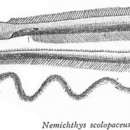The Snipe Eels (family Nemichthyidae) are delicate, elongate, ribbonlike deep-sea eels with compressed bodies and extremely long tapering tails. Their long, slender beaklike jaws, with inward pointing teeth, are curved, bending away from each other and not closing completely (the beak disappears in mature males, which at one time were believed to represent a distinct genus!). They lack scales and the dorsal fin extends far forward, almost to the head. Their anal fins are higher than their dorsal fins. The snout is shorter in males than in females. The anus is located far forward, at the throat, below or just behind the pectoral fin. These slender eels may exceed 120 cm in length. According to Eschmeyer and Herald (1983), snipe eels apparently orient themselves vertically in the water with the mouth pointing upward and are thought to feed on pelagic crustaceans, capturing them by entangling the crustaceans’ antennae in their jaws. (Eschmeyer and Herald 1983; Robins and Ray 1986; Charter 1996) All nine described snipe eel species inhabit relatively deep midwaters. In the Atlantic off North America, just one snipe eel,
Nemichthys scolopaceus (Slender Snipe Eel), enters shelf waters.
Nemichthys species have filamentous tails and a lateral line consisting of three rows of pores. They may have as many as 750 vertebrae.
Nemichthys scolopaceus is brownish or gray with darker brown fine speckling. For technical descriptions, see Charter (1996) and the online
Fishes of the NE Atlantic and the Mediterranean. In the western Atlantic, this species is found from Nova Scotia (Canada) and the northern Gulf of Mexico to Brazil and in the eastern Pacific it is found from British Columbia (Canada) to Peru, including the Gulf of California, but the species is found worldwide in temperate and tropical waters. The Slender Snipe Eel is usually found between 200-500 m depth, but sometimes much deeper, and it occasionally occurs in shallower waters in the northern part of its range. (Castle 1986; Robins and Ray 1986; Charter 1996) The Slender Snipe Eel is restricted to the ocean throughout its life cycle, unlike some other eels. At maturity, both sexes lose their teeth, although only males lose them all. These eels mature in deep water, but the immature stages (leptocephali) are found in shallow water near the shore. These eels may be semelparous, i.e., dying after spawning once. (Finch 1990 and references therein) Charter (1996) describes the leptocephali of this and other snipe eels.

